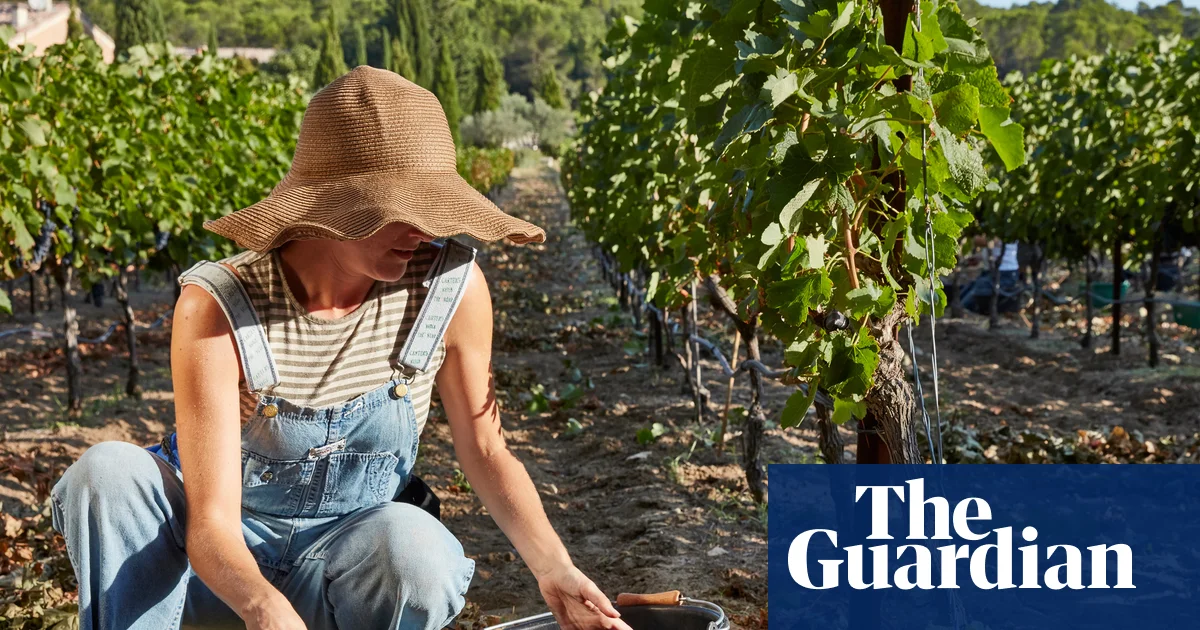‘Sweat, dirt and grape juice – it’s incredibly rewarding’: volunteer harvesting on a vineyard in France | France holidays
The wind whips the grapevines, turning my meditative picking stance into a full-body workout. I firmly plant my legs, stabilising a thrashing branch with my left hand as my right snips off a bunch of grapes. Local people claim the roaring mistral wind makes you crazy, which I can appreciate as each arid gust chaps my lips and desiccates my eyes.
I’m at Domaine Rouge-Bleu, an organic vineyard in the Côtes du Rhône wine region in southern France. I have volunteered for les vendanges, the autumnal grape harvest where backbreaking work is doused in camaraderie.
Participating in this time-honoured tradition had long been a dream of mine, a lifelong Francophile and food writer. So, in 2017, eager to understand more about winemaking beyond the bar stool, I joined a motley crew, trading sore arms and farmer tans for a hands-on course in viticulture and viniculture. I expected to gain an oenological education. I had not anticipated how hard the picking would be – nor how gratifying it felt to accomplish something so big together. Many vendangeurs go back for more. I have returned almost every year since my first harvest, becoming friends with the owners of Domaine Rouge-Bleu.
France is one of the top producers of wine worldwide, pouring 4.78bn litres of wine into the market each year. About 59,000 winemakers manage 789,000 hectares (nearly 2m acres) of vineyards. That’s a lot of grapes to pick. Since the Greeks first planted vines in France in the sixth century BC, raisins (grapes) have been harvested by hand. Machines arrived in the 1960s for speed and cost efficiency. Yet 30%-40% of French wineries still retain the traditional vendanges à la main (hand-picked harvests).
Why would a winemaker opt for a method that costs more time and money? Renowned regions such as Champagne are required to do so to deliver the clusters to the press house intact. Grapevines can grow too close together to allow a machine to pass through. Some winemakers believe machines harm the vines and grapes. “You get better quality by hand since you only pick good grapes, without leaves, vines or oil from the machine,” says Thomas Bertrand, who co-owns Domaine Rouge-Bleu with his Australian partner Caroline Jones.
The hard-working couple illustrate the realities of winemaking that are far from the glamour of Bordeaux chateaux. They bring in volunteers to cut costs. However, harvest volunteers are a legal minefield in France. The government insists winemakers pay harvesters, so some offer room and board in lieu of wages, though many refrain from doing so to avoid any issues. Many winemakers wish volunteers were recognised, for communal harvests have been part of the winemaking heritage for centuries. “Our métier is all about sharing and creating convivial moments,” says France Breton, who welcomes volunteer harvesters at Domaine Breton in the Loire.
For example, Vignerons Indépendants de France runs the Vendangeur d’un Jour (harvester for a day) programme across France from late August to early October. “It is wonderful for wine tourism since so many want to pitch in,” says Jean-Marie Fabre, president of the association. You can also find opportunities on volunteer work sites such as WWOOF. I contacted wineries direct via introductions by my local wine bar, eventually finding Domaine Rouge-Bleu through its former owner, whose wife runs the French Word-A-Day blog.
Domaine Rouge-Bleu is in Sainte-Cécile-les-Vignes, a small town of 2,900 off the tourist track, despite its location in Provence. Fittingly for the town name – vignes are vines – the flat landscape is blanketed with grids of vineyards, with Mont Ventoux, the legendary Tour de France thigh-thumper, looming in the distance. At the end of a picturesque driveway lined with olive trees, a 17th-century farmhouse is home to Thomas, Caroline and their two girls. In harvest season, it swells with vendangeurs. I hit the roommate jackpot with Hannah, a perky Brit who works at a wine shop. Our 16-person team hails from France, the UK, Ireland, Australia and the US, my homeland.
Each morning, the smell of coffee wakes us before 7am. We don clothes that we don’t mind getting dirty – grape juice stains are stubborn. Despite the heat, we wear thick socks under our boots to avoid burs scraping our ankles. Thomas gives us a lay of the land on the first day. The first rule of picking is to be gentle with the grapes. Manhandling them can break their skins prematurely, causing the oxidation that negatively affects aromas and flavours.
We should also watch out for oidium, a chalky mildew, because “crap grapes make for crap wine”, says Thomas. When I find a snail on a grape, he jokes: “That’s why wine isn’t vegan.” (He jokes fluently in English.) Snipping grapes eight hours a day for three weeks wreaks havoc on the hands. Cuts are so prevalent I become the unofficial nurse of the group, carrying plasters in my bumbag. We work in pairs, bookending the vines to ensure no bunch gets left behind. To break up the monotony, conversation inevitably flows, profound at times due to the thick vines that block our faces like confessional screens. Everyone has a story – healing from a breakup or breaking free from a corporate job.
This sociability is an antidote to the demanding work: the constant ache in muscles I never knew I had; the unrelenting sweltering sun and hot wind. My skin and clothes are sticky with sweat, dirt and grape juice, my fingernails permanently painted purple. Yet, knowing our collective efforts will be bottled into delicious wine is incredibly rewarding. “There’s no feeling like people coming together for a shared mission,” says Hannah.
after newsletter promotion
What is surprising to me is that I find solace in the repetition. As a freelancer weighted with managing, and finding, my own work, I appreciate having specific tasks; being told what to do; the simple choreography of snip, haul, repeat. Plus, the monotony is broken up by the varied terrain.
Terroir, the buzzword that rolls off sommeliers’ tongues, refers to the soil, climate and sunlight that give wine grapes their distinctive character. I get a crash course on Rouge-Bleu’s 12 hectares planted with 21 grape varietals. Stooped low like elderly ladies, the 115-year-old grenache gobelet vines are planted in an ancient riverbed of large white stones. While these heat-retaining galets help the grenache reach peak ripeness, their uneven surface is torturous – like trying to balance in a ball pit. The trellised syrah are easier to pick, their extended branches welcoming us with open arms to gather their purple jewels.
Once we fill the trailer – emblazoned with an “In Grenache We Trust” sticker – we head back to the winery. This entails a different workout – manoeuvring hoses and vats, loading the press, shovelling grape bunches into the tank. “We keep their stems to reduce heat buildup during fermentation, which leads to the jammy flavours we don’t want,” says Caroline. I appreciate her red wines even more with this knowledge. My favourite task is climbing into the press to stomp out every last drop of juice.
The drudgery is lessened as we toast the day’s end with craft beers from a friend’s Alpine brewery. “It takes a lot of beer to make good wine,” is a common harvest adage that Thomas repeats. Gathering around the table for meals is a harvest highlight, a much-deserved moment of conviviality that reinforces our team spirit and recharges our batteries. Each night, a different harvester cooks a recipe of their choosing, often calorie-replenishing meals such as lasagne, grilled sausages or chickpea curry. Naturally, the meals are paired with Domaine Rouge-Bleu’s bottles, from its citrusy white Dentelle to the luscious Lunatique that bursts with blackberry notes. The most oenologically curious of us have a vertical tasting for a nightcap – by sampling the same wine from different years, we can taste how age intensifies its flavours.
Just as a fine wine lingers in the mouth, participating in a wine harvest is an enduring experience. A fellow harvester, Oscar, goes so far to say: “It’s about as useful a thing a person could do.” Each time I drink wine, I taste its people, its place, its story. My time among the vines has made me truly appreciate Louis Pasteur’s words: “There is more philosophy in a bottle of wine than in all the books in the world.”
Further information: Domaine Rouge-Bleu; Domaine Breton; Vendangeur d’un Jour; WWOOF

